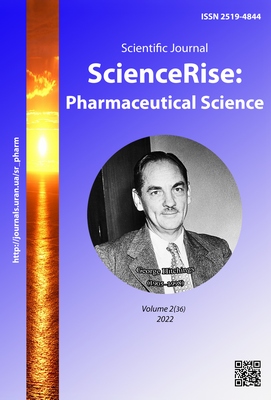Порівняльний аналіз споживання лікарських препаратів для лікування епілепсії в Україні, Казахстані й Білорусіїї
DOI:
https://doi.org/10.15587/2519-4852.2022.255840Ключові слова:
фармацевтичний ринок, обсяги споживання, епілепсія, протиепілептичні препарати, темпи приросту/убутку, Базовий перелік ВООЗ осовних лікарських засобівАнотація
Мета: провести порівняльний аналіз показників споживання населенням протиепілептичних препаратів на роздрібних фармацевтичних ринках країн, що розвиваються, зокрема України, Казахстану та Білорусіїї у період 2016–2020 рр.
Матеріали і методи. Об’єктами досліджень стали дані маркетингових агенцій, які займаються моніторингом внутрішнього фармацевтичного ринку в країнах, що досліджуються. Зокрема, асортимент протиепілептичних препаратів в Україні визначали, використовуючи систему дослідження ринку «Фармстандарт» компанії «Моріон». Використовувалися аналітико-порівняльний, системний, графічний, логічний, математико-статистичні методи досліджень.
Результати дослідження. Результати дослідження свідчать, що ринок протиепілептичних препаратів України, Казахстану та Білорусіїї переважно залежить від закордонних виробників, зокрема на 60 %, 92 %, та 46 % відповідно за даними 2020 р., і не забезпечує потреб населення у лікарських препаратах відповідно до рекомендацій ВООЗ. Встановлено, що на ринку України, Казахстану протягом 2016-2019 рр. спостерігається загальна тенденція збільшення обсягів роздрібних продажів протиепілептичних препаратів, які не входять до Базового переліку ВООЗ основних лікарських засобів, як в натуральному, так і в грошовому вимірах. Результати аналізу обсягів роздрібних продажів лікарських препаратів на ринку Білорусіїї у кількісному та грошовому вимірах вказують на збільшення обсягів реалізації лікарських препаратів для лікування епілепсії, які входять до Базового переліку ВООЗ основних лікарських засобів.
Висновки. Наявність в Україні складної ситуації зі споживанням протиепілептичних препаратів у порівнянні з іншими країнами референтної групи свідчить про необхідність впровадження комплексних програм протидії поширенню епілепсії та запровадження моделей раціонального використання обмежених ресурсів охорони здоров’я
Посилання
- Panfilova, H., Olkhovska, A., Boboshko, L., Iurchenko, G., Bandura, M., Dominik, Z. (2021). Results of a comparative analysis of the dynamics of healthcare expenditure from the GDP of countries, cash payments from families and state expenditures on healthcare in Ukraine, Poland and in the WHO European countries. ScienceRise: Pharmaceutical Science, 1 (29), 17–24. doi: http://doi.org/10.15587/2519-4852.2021.225443
- Kurylenko, Yu., Podgaina, M., Popova, I., Teterich, N. (2221). Investigating approaches to treating patients with atrial fibrillation based on the defined daily dose. PharmacologyOnline, 3, 60–66.
- Jamison, D. T., Summers, L. H., Alleyne, G., Arrow, K. J., Berkley, S., Binagwaho, A. et. al. (2013). Global health 2035: a world converging within a generation. The Lancet, 382 (9908), 1898–1955. doi: http://doi.org/10.1016/s0140-6736(13)62105-4
- Kotvitska, A. A., Cherkashyna, A. V., Volkova, A. V., Kubarieva, I. V. (2018). Analysis of the current state and the dynamics of lipid-lowering drugs in the pharmaceutical market of Ukraine. Asian Journal of Pharmaceutical and Clinical Research, 11 (6), 358–362. doi: http://doi.org/10.22159/ajpcr.2018.v11i6.22702
- Epilepsy: a public health imperative 2019 (2019). World Health Organization. Available at: https://www.ilae.org/files/dmfile/19053_Epilepsy_A-public-health-imperative-For-Web.pdf
- Shcho treba znaty pro epilepsiiu (2019). Tsentr hromadskoho zdorov’ia MOZ Ukrainy. Available at: https://phc.org.ua/news/scho-treba-znati-pro-epilepsiyu
- Beghi, E. (2019). The Epidemiology of Epilepsy. Neuroepidemiology, 54 (2), 185–191. doi: http://doi.org/10.1159/000503831
- Beghi, E. (2016). Addressing the burden of epilepsy: Many unmet needs. Pharmacological Research, 107, 79–84. doi: http://doi.org/10.1016/j.phrs.2016.03.003
- Interstate Statistical Committee of the CIS countries. Available at: http://www.cisstat.com
- Doslidzhennia farmatsevtychnoho rynku Ukrainy analitychnoi kompanii «Farmstandart» kompanii «Morion». Available at: http://www.pharmstandart.com.ua
- Klasyfikatsiia protyepileptychnykh zasobiv. Available at: https://pidru4niki.com/68255/meditsina/protisudomni_likarski_zasobi
- Wirtz, V. J., Hogerzeil, H. V., Gray, A. L., Bigdeli, M., de Joncheere, C. P., Ewen, M. A. et. al. (2017). Essential medicines for universal health coverage. The Lancet, 389 (10067), 403–476. doi: http://doi.org/10.1016/s0140-6736(16)31599-9
- Volkova, A. V., Korzh, Y. V., Olieinikova, N. V., Tereshchenko, L. V., Zaitseva, Y. L. (2019). The study of the epileptic population morbidity rate in Ukraine at the state and regional level. Social Pharmacy in Health Care, 5 (4), 14–22. doi: http://doi.org/10.24959/sphhcj.19.173
- Research of epilepsy in Ukraine. Available at: https://moz.gov.ua/article/statistic/centr-medichnoi-statistiki-moz-ukraini
- Unified clinical protocol of primary, emergency, secondary (specialized) and tertiary (highly specialized) medical care (2013). Available at: https://www.vnmu.edu.ua/downloads/pdf/OSKI_prot-epilep(dorosli)_med-ps-2020.pdf
- NICE CG 137 – The Epilepsies: The diagnosis and management (Epilepsy: diagnosis and treatment of epilepsy in adults and children in primary and secondary care) (2012). Available at: https://www.nice.org.uk/guidance/cg137
- Glauser, T., Ben-Menachem, E., Bourgeois, B., Cnaan, A., Guerreiro, C. et. al. (2013). Updated ILAE evidence review of antiepileptic drug efficacy and effectiveness as initial monotherapy for epileptic seizures and syndromes. Epilepsia, 54 (3), 551–563. doi: http://doi.org/10.1111/epi.12074
- Kwan, P., Arzimanoglou, A., Berg, A. T., Brodie, M. J., Allen Hauser, W., Mathern, G. et. al. (2009). Definition of drug resistant epilepsy: Consensus proposal by the ad hoc Task Force of the ILAE Commission on Therapeutic Strategies. Epilepsia, 51 (6), 1069–1077. doi: http://doi.org/10.1111/j.1528-1167.2009.02397.x
- WHO Model List of Essential Medicines (2019). Available at: https://apps.who.int/iris/bitstream/handle/10665/325771/WHO-MVP-EMP-IAU-2019.06-eng.pdf
- Cappello, B., Moja, L., Figueras, A., Magrini, N. (2020). The “Square Box”: Therapeutic Equivalence as a Foundation of the WHO Model List of Essential Medicines. Frontiers in Pharmacology, 11. doi: http://doi.org/10.3389/fphar.2020.578000
- Begley, C. E., Durgin, T. L. (2015). The direct cost of epilepsy in the United States: A systematic review of estimates. Epilepsia, 56 (9), 1376–1387. doi: http://doi.org/10.1111/epi.13084
- Allers, K., Essue, B. M., Hackett, M. L., Muhunthan, J., Anderson, C. S., Pickles, K. et. al. (2015). The economic impact of epilepsy: a systematic review. BMC Neurology, 15 (1). doi: http://doi.org/10.1186/s12883-015-0494-y
##submission.downloads##
Опубліковано
Як цитувати
Номер
Розділ
Ліцензія
Авторське право (c) 2022 Iuliia Korzh, Natalia Olieinikova, Marharyta Beketova, Inna Kubarieva, Evgenia Korobova, Olga Afanasenko

Ця робота ліцензується відповідно до Creative Commons Attribution 4.0 International License.
Наше видання використовує положення про авторські права Creative Commons CC BY для журналів відкритого доступу.









